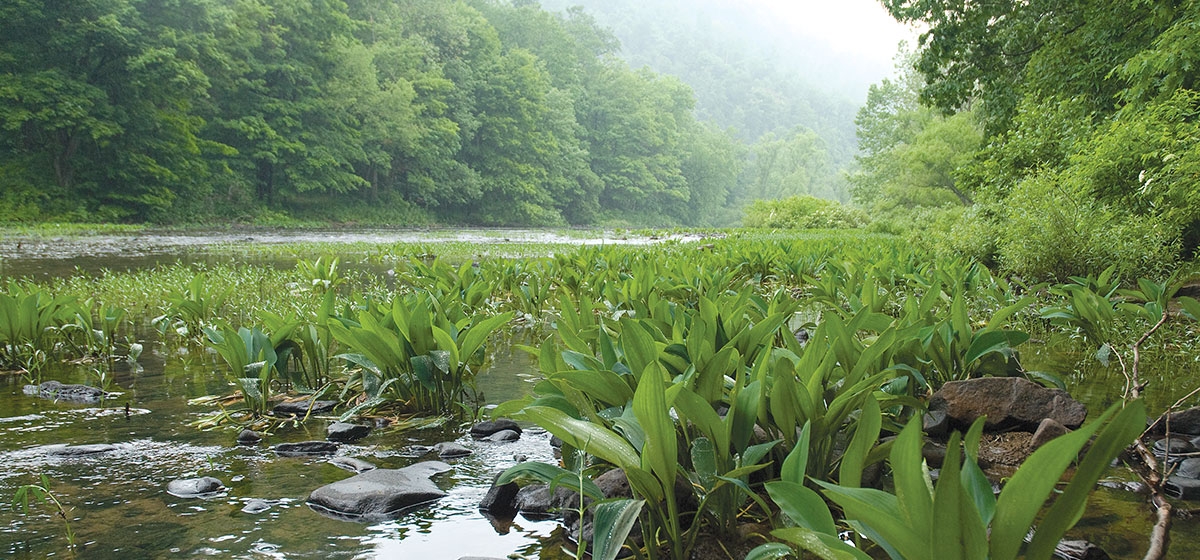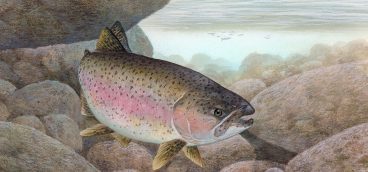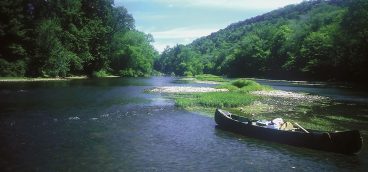Our Endangered River

It’s a crisp November morning, some 25 years ago. Bob Ging and Don Gales are hunting on a ridge in Lower Turkeyfoot, Somerset County, where green hemlocks mingle with bare winter hardwoods. “Boy, this is beautiful,” says Ging as sunrise reveals the emerald waters of Laurel Hill Creek in the valley.
Gales has a timber frame home there, and more than 20 acres bordered by state game lands and a small farm owned by an elderly woman the locals call Sara the Goat Lady. “If that farm ever comes up for sale, Bob, you could buy it,” Gales tells him, “and we’d have this whole valley and we could do anything we want with it.”
A few years later, Ging takes a break from his Pittsburgh law practice to backpack in the Allegheny National Forest. When he drops by the Westline Inn near Kane, Pa., there’s an urgent message to phone Gales. Sara the Goat Lady’s farm is up for sale. “I packed the tent, got in my Volkswagen, drove down here, found the Realtor, made a down payment and bought the farm.
“And we did end up doing everything we wanted to do in this valley,” says Ging, who built a log house along the lower stretches of Laurel Hill Creek, where he and his former Brookline neighbor set out to create a haven for the sporting life that drew them to the remote valley. They established a noncommercial pheasant preserve on their land. And they managed to get “delayed harvest” status for their stretch ofthe creek, which opens the water to year round trout fishing and requires anglers to release their catch during all but 10 weeks of the year.
What they could not foresee back on that late November morning was the growing thirst for water far upstream that today threatens the health of the Laurel Hill Creek watershed, their backyard fishery and a critical piece of the Laurel Highlands, southwestern Pennsylvania’s most popular region for outdoor recreation. Declining stream flow isn’t the only threat to the 38-mile-long Laurel Hill, but it clearly is the watershed’s biggest issue and a problem serious enough to warrant national attention.
When Pittsburgh hosts the United Nations World Environment Day in June, policymakers from around the world will need only to take a one-hour drive east to the Laurel Hill to see one of the 10 most endangered rivers in the United States, as ranked by the Washington, D.C.-based conservation nonprofit, American Rivers.
A critical moment
The cause of Laurel Hill Creek’s predicament is no mystery. Data show that the average amount of water withdrawn from the creek per day is nearly 60 percent greater than what the state estimates can safely be withdrawn without posing a risk to aquatic life. The lower stretches of the creek endure the greatest hardship, due to the fact that the greatest thirst for water is found in its uppermost reaches, where three state parks, two resorts, a limestone quarry and a municipal water plant reside within the watershed. This problem, which even in years of average rainfall results in frequent drought-like conditions during the summer months, is of growing concern.
The region’s rising popularity is inspiring ambitious plans for further development, and water-hungry natural gas wells are already being drilled just beyond the fragile watershed, where comprehensive water management is more concept than practice and regulatory protections against excessive water withdrawal are scarce. The coming months may offer insight into how those issues will be resolved or whether they will be resolved at all. Soon, the state Department of Environmental Protection (DEP) is expected to decide whether to designate the Laurel Hill Creek watershed as a Critical Water Planning Area, which, while offering no special regulatory protection, could help focus disparate stakeholders on solving watershed issues and offer them a blueprint for more prudently managing the resource.
Just as important is what DEP decides to do about renewing the water allocation permit for Somerset Borough’s municipal water plant, which accounts for just under 70 percent of the total volume withdrawn from the creek—a practice that’s become more controversial now that a new pipeline connects the borough to an abundant alternative water supply located well outside the troubled Laurel Hill Creek watershed. This moment of decision was not lost on American Rivers staff when they chose Laurel Hill Creek for its most endangered rivers list. “Choosing to give a river that status has two purposes,” says Liz Garland, associate director of the nonprofit’s clean water program. “One is that the situation is representative of an important problem that we need to pay attention to, and certainly water supply and retaining healthy in-stream flows are very important. The other is finding a river where there’s an opportunity to make an impact—where there’s a critical decision about to happen. When we look at Laurel Hill Creek, there is an opportunity for things to either go right or wrong in terms of the management it may look ok from here…but Laurel Hill Creek faces numerous challenges that have landed it on a “Top 10 Most Endangered Rivers” list.
Laurel Hill Creek is anything but a household name even throughout much of southwestern Pennsylvania. Yet, there is no shortage of interest in what its future holds. It’s an important piece of the Laurel Highlands and a key tributary of the Youghiogheny River, itself a major regional recreation resource and source of public water. With Seven Springs and Hidden Valley ski resorts on its ridges, miles of the Great Allegheny Passage bike trail, whitewater rafting, rustic bed and breakfasts and other attractions, the Laurel Highlands outdraws places such as Lake Erie and the Allegheny National Forest, adds nearly $800 million a year to the economies of three counties, and is a big reason why tourism accounts for about 19,000 jobs in a region that needs them.
“It’s just so peaceful,” Gales, a retired 25-year-career Marine, says of the appeal of the Laurel Highlands and the banks of Laurel Hill Creek, where he’s lived since 1976. “All you see is quiet country.” The headline of a feature article on the Laurel Highlands published last year in The New York Times put it this way: “Think Poconos, on the other side of Pennsylvania.”
The decades-long effort to protect the most popular creek within that quiet country involves an exceptional number of organizations, including the Somerset County Conservancy, Southern Alleghenies Conservancy, Western Pennsylvania Conservancy, Somerset County Conservation District, Mountain Watershed Association, Laurel Hill Creek Watershed Association, Youghiogheny Riverwatch, and Chestnut Ridge Trout Unlimited. “Some streams have only one of these groups, but interest in Laurel Hill Creek is very strong,” says Nick Pinizzotto, director of the Western Pennsylvania Conservancy’s watershed conservation program.
Nearly 29 percent of the 125-square mile watershed is protected as state forest, parks and game lands, and accounts for half of the length of Laurel Hill Creek. Two years ago, the Western Pennsylvania Conservancy added to those totals when it bought 2,300 heavily forested acres along the creek from a timber company. Four miles of Laurel Hill Creek flow through the large tract of uninterrupted wildlife habitat, that was conveyed to the state as an addition to Forbes State Forest. Thomas Saunders, president and CEO, says the conservancy is looking to buy more land in the watershed as part of its efforts to protect the Laurel Highlands. “What we’re looking for are large blocks of forest without roads and other interruptions. If you have that, you have a whole system functioning on the property, better protection for water as it flows down the creek, and an opportunity for natural communities and wildlife habitat to interact the way they should.”
Then there is the vigilance of watershed residents. Some rescue dying trout from the creek’s shallow late summer waters and take them to the deeper and cooler Youghiogheny River. Ging and Gales routinely run off poachers who appear after a trout stocking to fill their coolers with fish that regulations require them to release. Last year, Ging and a downstream neighbor did the same to the drivers of two tanker trucks they caught drawing water from the creek. “They were servicing a (natural gas) well on the top of the hill,” says Ging, a former assistant attorney general for the state Department of Environmental Resources. “We told them to get the hell out and don’t come back. They said, OK.”
History of a creek
Laurel Hill Creek forms in a farm field as a tiny stream about 10 miles east of the Donegal exit of the Pennsylvania Turnpike.
The watershed includes the east slope of Laurel Ridge and the creek flows as far south as Confluence. There, it and the Casselman River drain into the Youghiogheny River, a union that Native American scouts described to George Washington as a “turkeyfoot” when he came in 1753 as a 21-year-old to claim the region for Virginia. Rain and snow melt find the creek by way of 32 small, named tributaries, numerous unnamed tributaries, and shallow and deep groundwater, whose flow paths originate in aquifers of shale and sandstone. Four of the creek’s tributaries warrant “exceptional value” status, the DEP’s highest level of protection. The others, and Laurel Hill Creek itself, are classified a rank below as high quality coldwater fisheries. Some 73 percent of the watershed consists of undeveloped mixed forest that includes Eastern hemlock, yellow birch, white ash, red oak, sugar maple, tulip tree and black cherry. The rare Appalachian blue violet and mountain bugbane are found there. Its diverse wildlife population includes deer, bear, coyote, red fox, turkey, forest-nesting songbirds and protected species, such as the Northern river otter, bald eagle and Eastern hellbender salamander. Native American tribes, early European settlers and Civilian Conservation Corps workers have called it home. And at times it’s been a working waterway employed by mills and logging companies.
Seven Springs and Hidden Valley resorts, and Kooser, Laurel Summit and Laurel Hill state parks make the upper third of the watershed its most visited and heavily developed section. Seven Springs alone attracts some 1.5 million visitors a year to its ski slopes, 1,200 townhomes and condominiums and high-rise hotel, providing 1,500 jobs during high season. State parks draw another 500,000 visitors a year. And Hidden Valley, the smaller of the two resorts, is poised to expand with plans to add 1,800 more private homes, townhomes and condominiums. The first of two delayed-harvest sections of restricted fishing enters Laurel Hill State Park as a narrow trout stream that flows swiftly through heavy canopy. There, a steep forest trail offers a breathtaking view of the rolling water under the shade of massive old-growth Eastern hemlocks, which survived the clear-cut logging practices that stripped the ridge bald a century ago.
The creek then swells to become Laurel Hill Lake, a park attraction formed by a broad dam built during the Great Depression by men who found work in the Civilian Conservation Corps. From the lake’s outflow at Trent, and for several miles downstream, the Laurel Hill flows as an average-sized Pennsylvania trout stream whose often-sluggish waters are crossed by two covered bridges. The creek is impeded again at Whipkey Dam, where a 19th-century gristmill once stood, before assuming its most dramatic personality. Several miles downstream, the Laurel Hill enters its most remote stretch as it passes through State Game Lands 111 and a hemlock-lined gorge, where swift, frothy water navigates boulders, conjuring images of a Western trout stream. It leaves the game lands as the lower delayed-harvest section that Don Gales and Bob Ging helped establish, offering pocket water and riffles that in some places skirt walls of shale. In these reaches, the creek widens to rival the breadth of many Pennsylvania rivers. In Humbert, it passes underneath a third covered bridge before taking a lazy lap through tiny Ursina Borough and draining into the Youghiogheny.
Low by any standard
Imperiled water supplies are nothing new to southwestern Pennsylvania. An unwelcomed part of the region’s legacy of coal mining, steelmaking and manufacturing is the contamination of ground and sur-face water by acid mine drainage and other pollutants that has long occupied environmental agencies. But Laurel Hill Creek has managed to escape such problems.
The creek does receive agricultural runoff from a handful of farms that haven’t yet embraced effective soil management practices, as well as a certain amount of the chemicals used to treat the Pennsylvania Turnpike, and outlaw sewage from a few homes within the watershed. But, according to studies done as part of a 2005 river conservation plan commissioned by the Southern Alleghenies Conservancy, the overall quality of the water is good. What puts the Laurel Hill at grave risk is Pennsylvania’s other water problem. Diminished stream flow is most often thought of as an issue of the arid American West, where, for example, the decline of the Colorado River threatens the water supply of 30 million people in seven states. By comparison, Pennsylvania is a waterabundant state, yet mounting evidence suggests the resource is under stress. Pennsylvania experienced drought emergency conditions in five of the past seven years. Residential water use has soared from five to 62 gallons a day per person since 1900. And conflicts over water use are increasing across the state. Evidence of chronic low water levels in Laurel Hill Creek has accumulated over decades.
“Historically, it’s gotten worse. The most recent data show there’s a lot less water in the creek than there used to be,” says Daniel Galeone, a U.S. Geological Survey hydrologist who investigated the issue as part of a water management plan prepared by Chestnut Ridge Trout Unlimited and the Somerset County Conservation District. The DEP uses a complex mathematical formula to estimate the maximum amount of water that, on average, can be withdrawn from a stream without harming aquatic life, which for the sake of measurement in Pennsylvania means brook trout. According to those criteria, 1.4 million gallons of water a day can safely be withdrawn from the Laurel Hill Creek basin.
By Galeone’s calculations, an average of nearly 2.2 million gallons a day is taken. Timing is everything when assessing the impact of excessive withdrawals. In times of heavy snow melt or rainfall, streams swell with water to spare. “If you’re doing that during the winter, it’s usually not a big deal,” Galeone says. “But wait a few months and it becomes much more critical.” That’s the case on Laurel Hill Creek, where summer flows frequently fall to levels that make for easy rock hopping. A 2005 analysis of stream flow data dating back to 1918 found that low flow conditions have occurred significantly more often in recent years, even when rainfall differences are considered. During such periods, downstream sections can shrivel to a third of their normal width. Laurel Hill Creek is one of the heaviest stocked trout streams in Pennsylvania,and several of its tributaries hold native brook trout. Chronic low-flow periods create conditions detrimental to both fish and the aquatic insects they feed on.
“You just don’t have as much wetted area of the stream,” says Pennsylvania Fish and Boat Commission biologist and Southwest Region fisheries manager Rick Lorson. “The bugs are produced in the riffles. If there aren’t enough submerged riffles, you don’t have as much production and there’s going to be warming of the water.” Late-summer water temperatures that exceed 85 degrees Fahrenheit in parts of Laurel Hill Creek spell trouble for brown and rainbow trout, whose optimum habitat is water ranging from 50 to 60 degrees in temperature. In fact, low flow and spikes in temperature are the chief reasons why, by Lorson’s estimates, fewer than 5 percent of trout stocked in May survive the summer.
Simple solutions
As solutions to serious water problems go, withdrawing less water from Laurel Hill Creek is far less technically challenging and less expensive than mitigating insidious ground and surface water contamination. “If you have acid mine drainage, it’s pretty hard to lick that stuff,” says Ging, whose law practice followed him from Mt. Washington to the banks of the Laurel Hill more than two decades ago, and who has largely focused on environmental litigation since then. “Our problems are not like that. Most of the problems on this watershed can be solved fairly easily.”
Whether the creek’s stream flow problem will be solved is another question. The creek is in the Ohio River basin, which, unlike the Delaware River and Susquehanna River basins, lacks an independent commission with authority to regulate how much water is taken from a tributary. Moreover, DEP’s authority over withdrawals is limited. Only public water suppliers and natural gas wells fall under the jurisdiction of the department, which issues the permits needed to draw surface water from streams or, in the case of gas wells, groundwater from aquifers. With public water plants, DEP rules only apply to surface water. “We have limited authority, and there’s a diminished amount of authority in the Ohio basin compared to the other basins,” says David Jostenski, chief of DEP’s Water Use Assessment Section. “Nevertheless, a good amount of the water in the Laurel Hill Creek watershed is utilized by a public water supplier.”
That supplier is the Municipal Authority of Somerset Borough’s 56-yearold water plant, which finds itself in the cross hairs of the controversy over the future of Laurel Hill Creek. Its permit to withdraw 1.75 million gallons of surface water a day lapsed several years ago, and DEP is still deciding whether to renew it. Most of that water never returns to the Laurel Hill. The borough itself is not in the watershed and neither are most of its customers, including two state prisons, one of which serves as the central laundry facility for the entire state prison system.
Fanning the controversy is the fact that the borough is competing with Somerset County over water customers. The county is selling water from the ample supply it and Cambria County own in reservoirs located outside of the Laurel Hill Creek watershed, the largest of which is the Quemahoning Reservoir, capable of providing up to 70 million gallons a day. A new pipeline connects Somerset Borough and several other municipalities to that water, including Jefferson Township, which encompasses the upper Laurel Hill watershed. Jefferson officials recently announced plans to buy water from the county rather than the borough. And Somerset Borough itself is buying 900,000 gallons of water a day from the county’s Quemahoning supply, raising questions about the need for its water plant to continue taking water from the stressed Laurel Hill. Several requests to discuss these and other issues were made to the Somerset Borough manager’s office during the preparation of this article, but received no response.
When Somerset County Commissioner John Vatavuk voted for building the Quemahoning pipeline, he did so with the expectation that it would ease low water conditions on Laurel Hill Creek. When asked if the county is willing to sell the borough more water in order to accomplish that, he replies: “Anything we could do to sell more water, I’d think, would be OK with the county.”
Comprehensive water management planning is something the watershed has never had, but which Deb Simko hopes will soon begin to take form. As vice president of Chestnut Ridge Trout Unlimited and a watershed consultant, she spent much of the past 18 months drafting a water management plan for the Laurel Hill. The plan gathered evidence on stream flow, impact on habitat and land use in support of the Laurel Hill’s nomination to become one of the first watersheds designated a Critical Water Planning Area under Pennsylvania’s newly revised water act.
“The idea is not to shut anybody down. That was the greatest fear: Are you doing this to shut down Seven Springs and Hidden Valley?” says Simko. “No, they provide a lot of jobs on the mountain. The idea is this water is important to all of us. Let’s all come to the table and work out solutions.” Critical Water Planning Area designation could for the first time offer a detailed plan for managing the watershed, convene stakeholders around important issues, and help them to make better-informed decisions affecting the future of Laurel Hill Creek. Several of the stakeholders are already meeting to discuss watershed issues as part of drafting the water management plan, including representatives from the two resorts. And Seven Springs recently took steps, such as installing low-flow showerheads and systems to recycle its potable and snowmaking water, that the resort says reduces consumption by 3.6 million gallons a year.
Solving the Laurel Hill’s problems will require measures much larger in scale. But even as a Critical Water Planning Area, no one would be required to adopt such measures. Nor would designation add any regulatory muscle. “Although implementation is voluntary, we’re hoping that water users will understand and appreciate the need to work together,” says DEP’s Jostenski. “But we haven’t gone through one of these entirely, so I can’t say exactly how it will play out.” In a sense, Laurel Hill Creek has emerged as a high-profile test of the state’s new water plan and whether DEP is able to rally a diverse group of stakeholders and use its limited regulatory authority to restore health to a watershed where the problem is well documented, the solution is apparent, an optional water source is available, and the value of saving it is great.
For his part, Ging chooses to remain vigilant. As an attorney and advocate, he’s experienced in such matters. His investigation of the mine discharge that killed 47 miles of the Casselman River in 1993 led to the largest mining penalty imposed by DEP and the restoration of that river. He’s been involved in the Laurel Hill from the time he moved to the valley and met its active corps of local conservationists, including Jim Moses, founder of the Laurel Hill Watershed Association, who Ging considers the hero of the watershed. “A lot of people have worked a lot of years on this,” Ging says. “But Jim is retired now, and I’m 20 years older than when I started. And there aren’t a lot of young people involved, which is a concern. Because with something like this, it’s a constant battle.”




